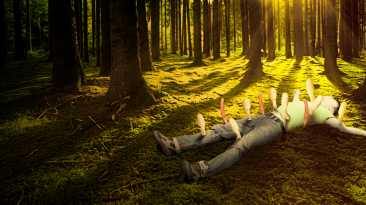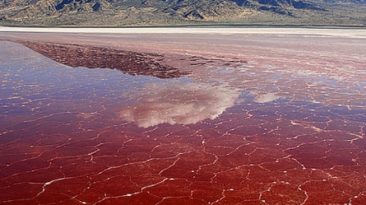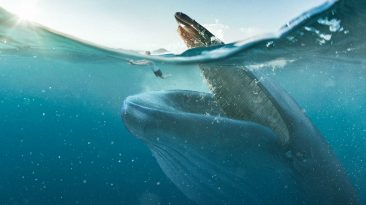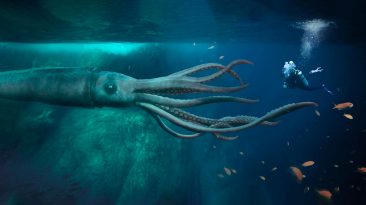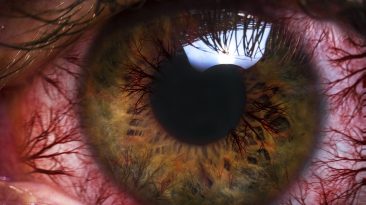Would you need a diving suit? How cold would the pool be? And would the methane fumes choke you to death?
Maybe you can handle diving into icy cold water, but hold off on jumping into this lake. It’s not as harmless as it looks. Beneath this sheet of ice lies methane gas. But it may not stay there long.
Known as thermokarst lakes, these bodies of water emit the greenhouse gas during the summer and trap it underneath the frozen water in the winter. Remnants of the Ice Age, these pockets of methane are released by permafrost thawing, brought on by Global Warming. In 2017, photographs revealed 200 new thermokarst lakes in Siberia. So, these lakes are freshwater mixed with methane. But if you dipped your toes into liquid methane, would you get frostbite?
As usual, let’s set the scene. You won’t stumble across any methane pools unless you’re on Saturn’s moon, Titan. But if you were to make a pool for liquid methane, the temperature would need to be well below freezing.
First, you’d need a large indoor pool area, where you can control the ventilation and the temperature. After all, our planet has never been colder than Antarctica’s record-breaking -89.2°C (-128 °F), set in 1983. To turn methane gas into a liquid, you’d have to cool it, and everything around it, down to -160°C (-256°F).
And if it gets warmer, it will turn from non-flammable liquid methane into a time bomb. Remember, methane is one carbon atom and four hydrogen atoms. And methane is the main ingredient in natural gas, which many people use to heat their homes.
You’d need to create a way to safely burn off the methane gas escaping from your pool. If you didn’t, you’d release more greenhouse gas into the atmosphere. So, assuming you cooled the methane just enough to keep it liquid, what’s the rest of the plan?
When you make that jump, one thing is certain. You’re going to sink, and probably fast. With its low viscosity, or, uh, gooiness, and low surface tension, even the smallest bug would fall right through the surface of liquid methane.
And liquid methane has a low density. So as you swim, every stroke will have less force than if you were treading water. If you want to practice beforehand, you could try jumping into a thermokarst lake.
But even that won’t prepare you for the dark cold of a methane pool. If you’re determined to do this, you’ll need some serious protection. You’ll risk permanent injury or even dying from the extremely cold temperature.
Frostbite starts at temperatures below 0°C (32°F). And depending on the wind conditions, it can occur in about five minutes. And If your eyes aren’t carefully protected, you could get corneal frostbite.
Just imagine two ice cubes where your eyes used to be. And you’re not going to want the liquid methane near your face either, although methane isn’t toxic. But a high concentration of methane gas can displace the all the oxygen around. So just a small mouthful of liquid methane could be enough to thaw out inside your lungs and suffocate you to death.
This gas isn’t something to be taken lightly. Did I mention that methane gas is 84 times more potent than carbon dioxide? And a study by the Environmental Defense Fund found that methane emissions cause 25% of today’s global warming. In nature, methane gas has no odor.
To alert us to this dangerous gas, mercaptan is mixed with methane, giving it the “fragrant scent” we all know and love. So while you might suffocate, freeze, or sink in liquid methane, at least what the rescuers find – whatever’s left of you – won’t reak too bad.
Sources
- “Methane: The other important greenhouse gas”. edf.org
- “Main sources of methane emissions”. 2014. What’s Your Impact.
- “Termites: A Potentially Large Source Of Atmospheric Methane, Carbon Dioxide, And Molecular Hydrogen”. ZIMMERMAN, P. R., J. P. GREENBERG, S. O. WANDIGA, and P. J. CRUTZEN. 1982. Science 218 (4572): 563-565. doi:10.1126/science.218.4572.563.
- “The Coldest Temperatures Ever Recorded On Earth”. Worldatlas.
- “Methane”. 2021. ccohs.ca.
- “Rising global temperatures are creating bubbling, methane lakes you can light on fire”. David Anderson and Chia-Yi Hou. 2021. Business Insider.
- “Methane And Frozen Ground | National Snow And Ice Data Center”. 2021. nsidc.org.













